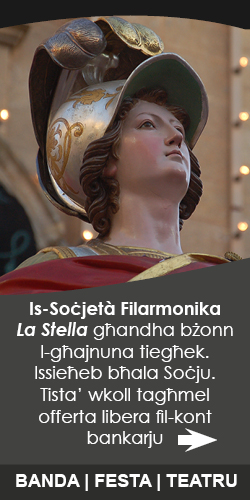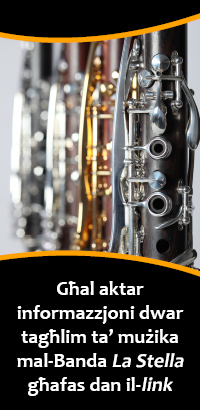VOCAL AND INSTRUMENTAL RECITAL AT AULA MGR FARRUGIA
Riding high on the wave of success, Myriam Cauchi gave a vocal recital at the splendid Aula Mgr Farrugia, within the environs of St George’s Basilica. The Aula, housing the Yamaha concert grand, is home to the chamber concerts which feature in 2 prestigious Festivals, namely, the annual Victoria International Arts Festival (June-July), and the Festival Mediterranea, currently in course. Also, a spate of other performers presents recitals in the exquisitely decorated concert hall throughout the year. St George’s is in fact well-known among locals and foreigners for its ceaseless promotion of high culture on the island.
Ms Cauchi, fresh from interpreting at the Teatru Astra, the role of Liú in Puccini’s masterpiece, Turandot, to great popular and critical acclaim, showed no signs of fatigue. Possessing a voice with a natural lyric timbre, not devoid of dark hues, underpinned by a flawless technique, Ms Cauchi sailed through the taxing programme with her customary charm, poise and ease. Accompanied by a most sensitive and accomplished pianist, Maria Frendo, Ms Cauchi scored high points for her interpretations characterized by attention to detail, correct formal approach to different styles, luscious phrasing and clarity of diction.
Ms Cauchi started the programme with Rossini’s L’Invito, a gem of song which captures the Italian master’s proverbial joie-de-vivre, and his seemingly unbounded zest for merriment and mischief. The song sparkles with spirit and caprice, possessing a firework of rhythm. Cauchi displayed a quasi-natural affinity with the composer’s traits. The capacity audience, made up mostly of German culture-minded tourists specifically in Gozo for Mediterranea, responded with spontaneous applause. Antonin Dvorak’s Gypsy Songs op. 45 come to symbolize independence and opposition to the constraints of middle-class life in both literature and music in the 9th century. Ms Cauchi interpreted 2 of them (2 & 4). A deep-seated sense of longing and yearning for a lost past of innocence untarnished by experience, characterizes the first song. The song is infused with a spirit of unbearable sadness, which is however sublimated through art. The 2nd song changes tact. It is an outburst of colour and contrast, spurred on by a heavily accented rhythmic piano score and a vocal line to match. Cauchi handled the change of style with admirable conviction and the appropriate vocal dynamics.
One of Malta’s leading cellists, Simon Abdilla Joslin, alternated with the soprano. A consummate musician, Abdilla Joslin has a singing tone and projects a mellow, warm timbre which has a most soothing effect on the listener. A flowing and richly-expressive style and superb playing characterized his beautiful interpretations. This could be felt in his emotionally charged rendering of Liszt’s famous Liebestraum, an immediate favourite with any audience. It was indeed an inspired interpretation, carrying Romanticism to great heights, and leaving an indelible mark in the soul. Saint-Saens is well-known for being seductive, capricious, melancholic and haunting. (Does not Rochester of Wuthering Heights spring to mind?) His Allegro Appassionato op. 90 is downright brilliant, exotic and makes great technical demands on the cellist. Abdilla Joslin carried off this cavallo di battaglia with panache’ and exuberance. It was a dazzling performance, imbued with fire and spirit, yet kept with bounds of reason.
Ms Cauchi took up once again centre stage, interpreting one of J Vella’s, the Festival’s artistic director, earliest works, Wahdi op 13. A proto-type of the Maltese lieder, Wahdi (lyrics by J.J. Camilleri), is a haunting song with a marked sense of longing coupled with a wistful recollection of times past. Vella’s penchant for sustained pianissimos is already present in this seminal work, as is his aptitude for continuous questioning, a legacy of what the Italians would describe as a “spirito irrequieto”. Cauchi and Frendo captured unerringly the essence of the lieder. Known as the Schubert of Italian songs, P Tosti’s rich legacy of opus, which is on a par with the lied composers of the 19th and early 20th centuries, is always a joy to listen to. Ideale is a classic, and has been sung by all time greats such as Caruso etc. It is a beautiful song, imbued with nostalgia, but without any hint of hopelessness. A soft piano accompaniment allowed the singer to weave a tapestry of enchanting sound producing a movingly poignant effect.
Abdilla Joslin followed in a similar vein with G Selmi’s Triste Canto, a somber yet ravishingly beautiful melody, supported by the piano’s rippling arpeggios and gently-syncopated rhythms. Abdilla Joslin concluded his recital with a bravura showpiece, Requiebros by G Cassado. A formidable cellist himself, Cassado is also a well-known composer. He dedicated this piece to Casals. In fact, the piece displays his intimate knowledge of the workings of the cello, and the instrument’s capability as an expressive force. It combines a dramatic force with vibrant energy and pathos. No wonder it is considered to be one of the most demanding pieces in the cello repertoire. It was a brilliant finish to a memorable recital.
The concluding pieces by Ms Cauchi were E Grieg’s Ich liebe dich and R Strauss’s Zueignung. A quintessential “nationalistic” composer, Grieg’s romantic vein with its plaintive appeal came across unhampered by any traits of artificiality. Ms Cauchi displayed her versatility and command of the language in a most convincing rendering of this lied. Strauss’s Zueignung, composed when he was 18, betrays his extraordinary ability to immerse himself wholly in the poem. This is particularly evident in this piece with its exquisite balance between the text and the music. Ms Cauchi’s interpretation highlighted the inner feeling of the words, bringing the highly-successful concert to a fitting close.
Indeed, the rapport between the three performers, sustained throughout the entire recital, guaranteed the very high level achieved. They performed as one, whether as piano/soprano duo, or piano/cello duo. It was music making at its finest. Maria Frendo also provided the highly-interesting and informative programme notes.
photos: Joe Attard



